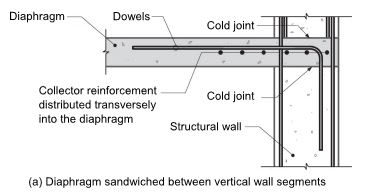chou09
Structural
- Oct 23, 2018
- 3
Hi, I am reading the design guide ''Seismic Design of Cast-in-Place Concrete Diaphragm, Chords, and Collectors''. In the guide it says ''Where the diaphragm is sandwiched between vertical wall segments, shear friction requirements must be satisfied through monolithic concrete at face of the wall using dowels and through the two cold joints using a combination of wall reinforcement and dowels''. Please see attached detail below.
According to our engineers, they never consider those cold joints as shear friction in new construction. The roughen face will interlock the concrete, so the wall can be treated as one piece.
My questions are:
1. Do we need to check the shear friction at those two cold joints?
2. If so, should we use only vertical rebars in shear wall for the check? Or can we account for concrete strength also?
3. Do we need to apply omega factor for the check?
According to our engineers, they never consider those cold joints as shear friction in new construction. The roughen face will interlock the concrete, so the wall can be treated as one piece.
My questions are:
1. Do we need to check the shear friction at those two cold joints?
2. If so, should we use only vertical rebars in shear wall for the check? Or can we account for concrete strength also?
3. Do we need to apply omega factor for the check?









